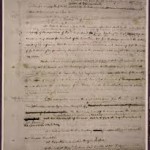James Madison is the Father of Note-Taking. Of course, the former US president is better known as Father of the Constitution, but that designation is at least partly the by-product of the man’s incredible note-taking prowess. As a delegate to the Philadelphia Convention in 1787, Madison took it upon himself to attend every session of the gathering, seated intently at the front table, keeping what he hoped might represent “an exact account of what might pass in the Convention.”[1]
Madison’s account was certainly not “exact,” but it’s the best we have –far better than the official record supposedly kept by convention secretary William Jackson. Yet there is something dangerous about Madison’s precedent. Modern-day note-takers of a Madisonian bent are common enough at good colleges like Dickinson. There are diligent students who aspire to take an “exact” record of what they hear in lecture or read for homework. Some scrawl or type pages of notes, after spending hours underlining texts. But is that approach really the best one?
The answer to that question depends on why you take notes. Students in introductory classes preparing for an exam have one set of priorities, but students in advanced topics or seminar classes who are busy developing projects or papers should have an entirely different set of note-taking priorities. It’s not about coverage in such cases, but depth that matters. It’s not about organizing facts for later studying, but rather about organizing your mind right now, to think.
How can you take notes that promote deeper thinking? Here are four suggestions to consider:
- Less is more. Forget about coverage. Aim for quality. Try to note and remember just a single memorable quotation, striking statistic or pivotal date that you can hold onto and use later in your own work. If that’s too easy, then try to remember one of each category, or a small handful, but keep your priorities short and you will undoubtedly remember them more.
- Time and space. Most note-takers, especially the studious ones, fall into the trap of following the lecturer’s or author’s structure. In other words, they summarize in linear fashion whatever they have heard or read. Don’t do that. Start with a chart, not a blank page, and try to put someone else’s idea into your framework. There are many possible frameworks, but the most helpful usually involve time and space. Build a one-page timeline template and then fill in key dates. Or start with a blank map and then arrange some key place marks.
- Re-mix. The best way to engage a topic is often to make it your own. Take somebody’s else’s key ideas and try putting them into a different format. Be creative. For example, Richard Beeman opens his narrative of the 1787 constitutional convention by identifying three “indispensable men,” James Madison “The Scholar,” George Washington, “The General,” and Benjamin Franklin, “The Doctor.” It almost sounds like a cartoon strip. Well, that’s one creative way to re-mix the argument –by turning Beeman’s narrative into a mock cartoon strip featuring an Avengers-style team of constitutional superheroes: The Scholar, The General and The Doctor. If that sounds silly, then remember that nearly all studies of the memory suggest that associating images with words is the surest way to remember them.
- 21st Century. Madison wrote in longhand on heavy paper, but he would have surely appreciated the ability to create searchable text safely tucked away in a digital file on the cloud. Don’t forget about the longterm advantages of digital storage for all of your notes, whether they are typed, scrawled, or drawn. You can create and store files in cloud-based services (such as Evernote or Dropbox) that will enable you to build a personal database of your evolving thoughts. Your own mind is your greatest database, but the idea of supplementing it with an interconnected and seamless record of your key thoughts and studies –one that is portable across devices and secure over time– is a powerful one that should appeal to everyone, most especially those would-be Madisonian note-takers.
[1] Quoted in Richard Beeman, Plain, Honest Men: The Making of the American Constitution (New York: Random House, 2009), 85.

